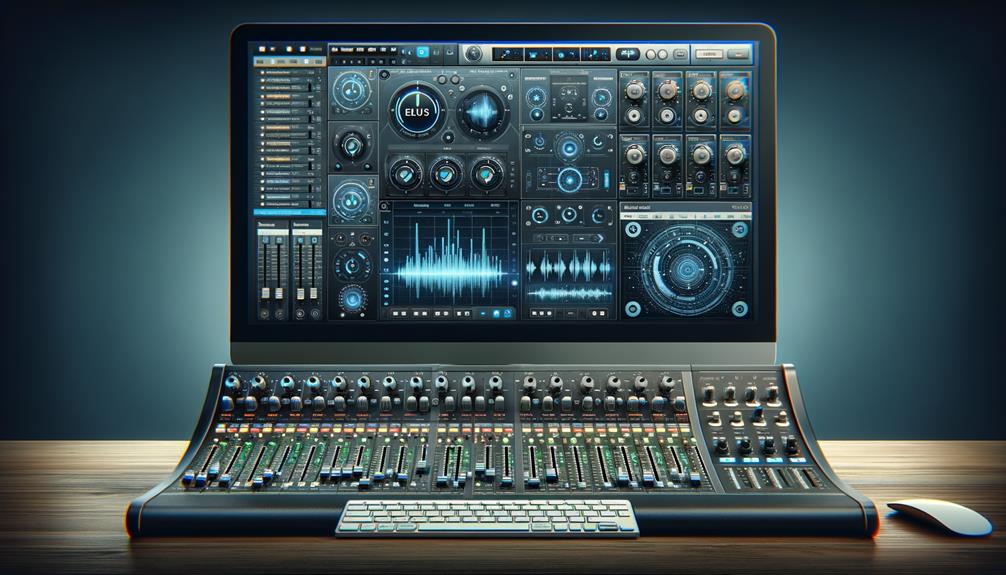Mastering percussion tracks in Logic Pro X involves a detailed process focused on achieving a polished sound. Begin by evaluating your mix for balance and adjusting frequencies using the channel EQ. Apply multiband compression to control dynamics while maintaining proper loudness levels, ideally around -14 LUFS. Employ stereo widening to enrich spatial presence and utilize high-pass filters to eliminate unnecessary low-end clutter. Incorporate reference tracks to set benchmarks for quality and tonal balance. Finally, engage with online communities for feedback and support, allowing you to refine your techniques and enhance your mastering skills further.
Key Takeaways
- Start by evaluating the percussion mix for balance and identify any imperfections that need addressing.
- Use Logic Pro X’s channel EQ for subtle frequency adjustments, limiting changes to a maximum of 2dB.
- Apply multiband compression with a target of -2dB gain reduction to control dynamics effectively.
- Incorporate stereo widening techniques to enhance the spatial presence of the percussion tracks.
- Regularly reference professionally mastered tracks to ensure your percussion mix meets industry standards.
Overview of Logic Pro X
Logic Pro X stands as a premier digital audio workstation (DAW) tailored specifically for the Apple ecosystem, catering to both novice and seasoned music producers. Priced at approximately $200, it presents a budget-friendly alternative in the competitive arena of music production software.
The platform boasts an extensive array of stock plug-ins available for users, essential for effective mixing and mastering. Its intuitive design greatly enhances workflow efficiency, enabling users to navigate seamlessly through various tasks. Additionally, Logic Pro X includes valuable tutorials that help users maximize the potential of its features. Furthermore, it is recognized for its exceptional sound quality, which is crucial for professional music production.
However, it is vital to note that this DAW is exclusively designed for Mac users, limiting accessibility for those outside the Apple environment.
Understanding the Mastering Process
Mastering serves as the pivotal concluding phase of music production, where the final mix is refined and polished to meet industry standards. This process distinguishes itself from the recording process and mixing by focusing on the entire track rather than individual elements.
During mastering, it is essential to make sure the mix is evaluated for readiness and free from audio imperfections. Proper headroom, ideally between -3dB and -6dB, should be maintained to avoid distortion.
Additionally, mastering prepares tracks for distribution across various platforms, ensuring they meet appropriate loudness levels, typically around -14 LUFS for streaming services.
To achieve the desired sound, mastering engineers often add plug-ins that enhance clarity and depth, solidifying the track’s professional quality. This includes techniques like dynamic range adjustment to maintain clarity without sacrificing impact.
Techniques for Mastering Percussion
Achieving excellence in percussion mastering requires a meticulous approach that balances technical precision with creative insight. Begin by evaluating your percussion mix, ensuring components like the kick drum and snare drum are well-balanced and free from imperfections. Utilize Logic Pro X’s channel EQ for subtle frequency adjustments, limiting cuts or boosts to 2dB. Apply multiband compression for dynamic control, targeting -2dB gain reduction. Employ stereo widening techniques to enhance spatial presence while avoiding phase issues. The use of high pass filters can also help eliminate unnecessary low-frequency clutter for a cleaner mix. The table below outlines essential tools you need for effective mastering:
| Tool | Purpose |
|---|---|
| Channel EQ | Frequency adjustments |
| Multiband Compressor | Dynamic control |
| Stereo Widening | Spatial enhancement |
| Reference Tracks | Competitive sound quality |
| Analyzer | Visual feedback on frequency range |
Importance of Reference Tracks
While the creative process of crafting a percussion track can be deeply personal, incorporating reference tracks greatly enhances the objective quality of the final product.
These reference tracks serve as benchmarks for sound quality, dynamics, and tonal balance, guiding your mixing decisions effectively. By selecting tracks from the same genre that share a similar recording process, you establish realistic expectations and maintain focus on your artistic vision.
The objective comparison facilitated by reference tracks allows you to identify areas needing improvement, such as loudness and frequency response, ultimately refining your mix.
Opting for professionally mastered tracks known for their clarity guarantees you are aligned with industry standards, saving time and preventing over-processing while elevating the overall impact of your work. Additionally, utilizing advanced audio processing tools can enhance the clarity and uniformity of your percussion tracks, ensuring they stand out in any mix.
Final Adjustments and Community Engagement
Polishing a percussion track to perfection involves a meticulous review of the final mix, where the goal is to identify and rectify any lingering imperfections such as pops, clicks, or inconsistencies.
During this phase, employing a metronome can guarantee that all percussion elements align seamlessly with the track’s rhythm.
Once the final adjustments are made, engaging with online audio communities can greatly enhance your mastering journey; sharing experiences and seeking feedback fosters a collaborative environment.
Encouraging discussions about specific mastering techniques can lead to invaluable insights.
Additionally, revisiting reference tracks post-mastering guarantees your mix adheres to industry standards, ultimately maintaining a competitive edge in sound quality.
Embrace this community-driven learning for continuous improvement. Utilizing techniques like surgical EQ cuts can also help you refine the clarity of your percussion tracks.
Frequently Asked Questions
Can You Master a Track in Logic?
Yes, you can master a track in Logic Pro X. Effective track preparation and utilizing mastering techniques, such as EQ and multiband compression, facilitate essential audio enhancements, ensuring a polished final product ready for distribution.
How Do You Make a Drum Track in Logic Pro X?
Creating a drum track in Logic Pro X involves utilizing drum programming techniques and virtual drum plugins. Explore rhythmic patterns through MIDI sequencing, ensuring precision and creativity, while enhancing your track with effects and mixing for a polished sound.
What Is the Difference Between Mixing and Mastering?
Mixing techniques focus on balancing and enhancing individual tracks for artistic expression, while mastering tools guarantee the final product meets industry standards, enhancing overall sound quality and consistency across various playback systems in audio engineering.
Is Logic Pro Good for Mixing and Mastering?
Logic Pro is highly regarded for mixing and mastering due to its extensive mixing techniques and effective mastering tips. Its intuitive interface and robust stock plugins empower users to achieve professional results efficiently, catering to diverse audio projects.
Conclusion
Mastering percussion tracks in Logic Pro X encompasses a multifaceted approach that integrates technical proficiency and creative insight. By thoroughly understanding the mastering process and employing specific techniques tailored for percussion, one can considerably enhance the overall sound quality. The utilization of reference tracks serves as a critical benchmark, ensuring adherence to industry standards. Final adjustments, coupled with community engagement, foster continuous improvement and innovation in mastering practices, ultimately elevating the auditory experience for listeners.



